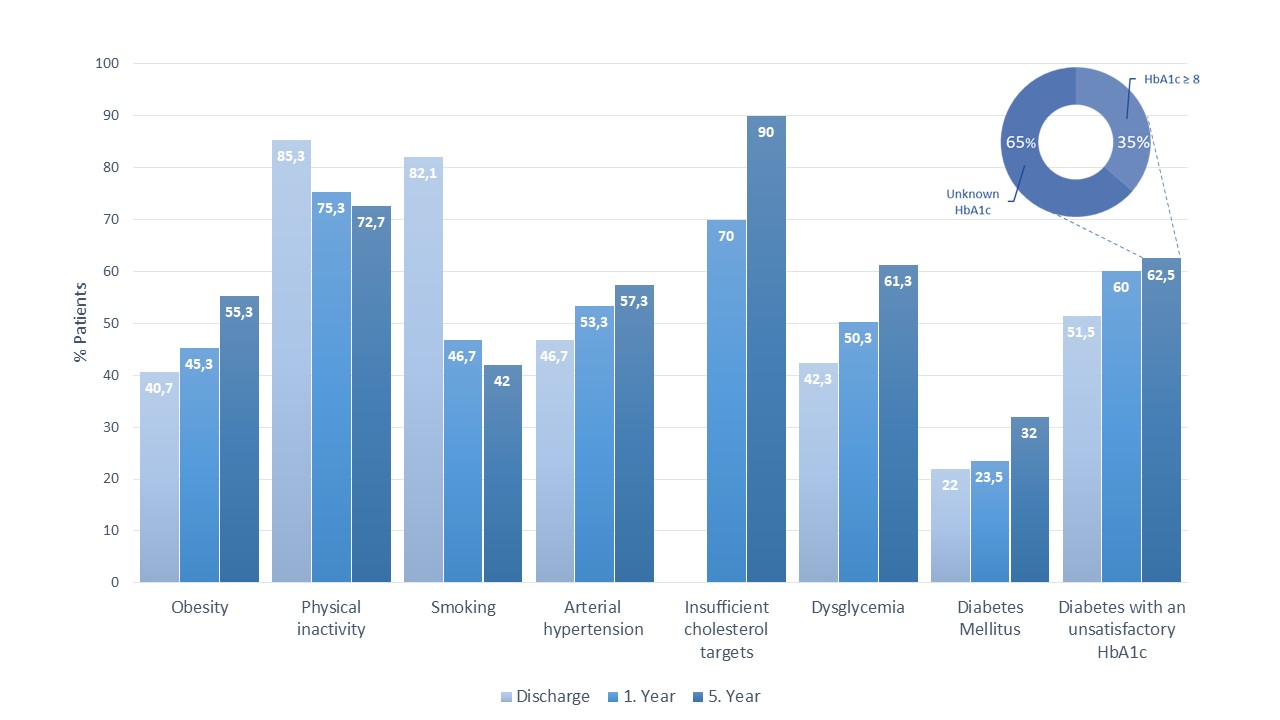Background
Young people are the backbone of every society; making secondary prevention of patients with myocardial infarction (MI) in this age category extraordinary important. In the present study, we investigated whether patients with MI ≤ 45 years old are adequately managed over long-term with respect to cardiovascular risk factor control.
Methods
All consecutive patients ≤ 45 years old with MI who were admitted to an over-regional heart center between 2015 and 2018 were included into the analysis. Patients were personally revisited one year and five years after MI to assess risk factor management.
Results
Out of 150 patients ≤ 45 years old with follow-up visit one year and five years after MI, the majority did not achieve guideline-recommended risk factor targets during the middle and long-term:
The rate of patients with obesity increased significantly from hospital discharge (n=61, 40,7%) to five-years follow-up (n=83, 55,3%, p<0,01). Most patients reported that they were physically inactive, even during the long-term: At one-year follow-up 113 patients (75,3%) performed leisure-time exercise less than 3 days per week. This rate did not improve significantly at five-years follow-up (n=109, 72,7%, p=0,50). 70 patients (46,7%) were persistent smokers at one-year follow-up. This result did not improve significantly at five-years follow-up (n=63, 42,0%, p=0,11). The number of patients with arterial hypertension increased significantly from hospital discharge (n=70, 46,7%) to one-year follow-up (n=80, 53,3%, p=0,01) and five-years follow-up (n=86, 57,3%, p<0,01). 105 patients (70%) did not attain cholesterol levels recommended by the valid international guidelines at one-year follow-up; this rate increased to 135 patients (90%) at five-year follow-up. A significant increase of patients with dysglycemia (HbA1c ≥ 5.7%) as well as diabetes mellitus was observed over time (see figure). 60% of the patients with diabetes mellitus (n=21) had unsatisfactory HbA1c-control (HbA1c >8% or unknown) at one-year follow-up. This result did not improve significantly at five-years follow-up (n=30, 62,5%, p=0,59).
Conclusion
In this study on young patients with MI, inadequate risk factor control with even a worsening tendency at middle and long-term follow-up was observed. Prevention efforts have to be intensified and individualized prevention programs should be implemented to assist young patients in achieving and maintaining healthy lifestyle and effective medical prevention after MI.
Figure: Risk factor control in n=150 patients ≤ 45 years with MI at discharge, one-year, and five-years follow-up.
<quillbot-extension-portal></quillbot-extension-portal>
https://dgk.org/kongress_programme/ht2023/aV374.html